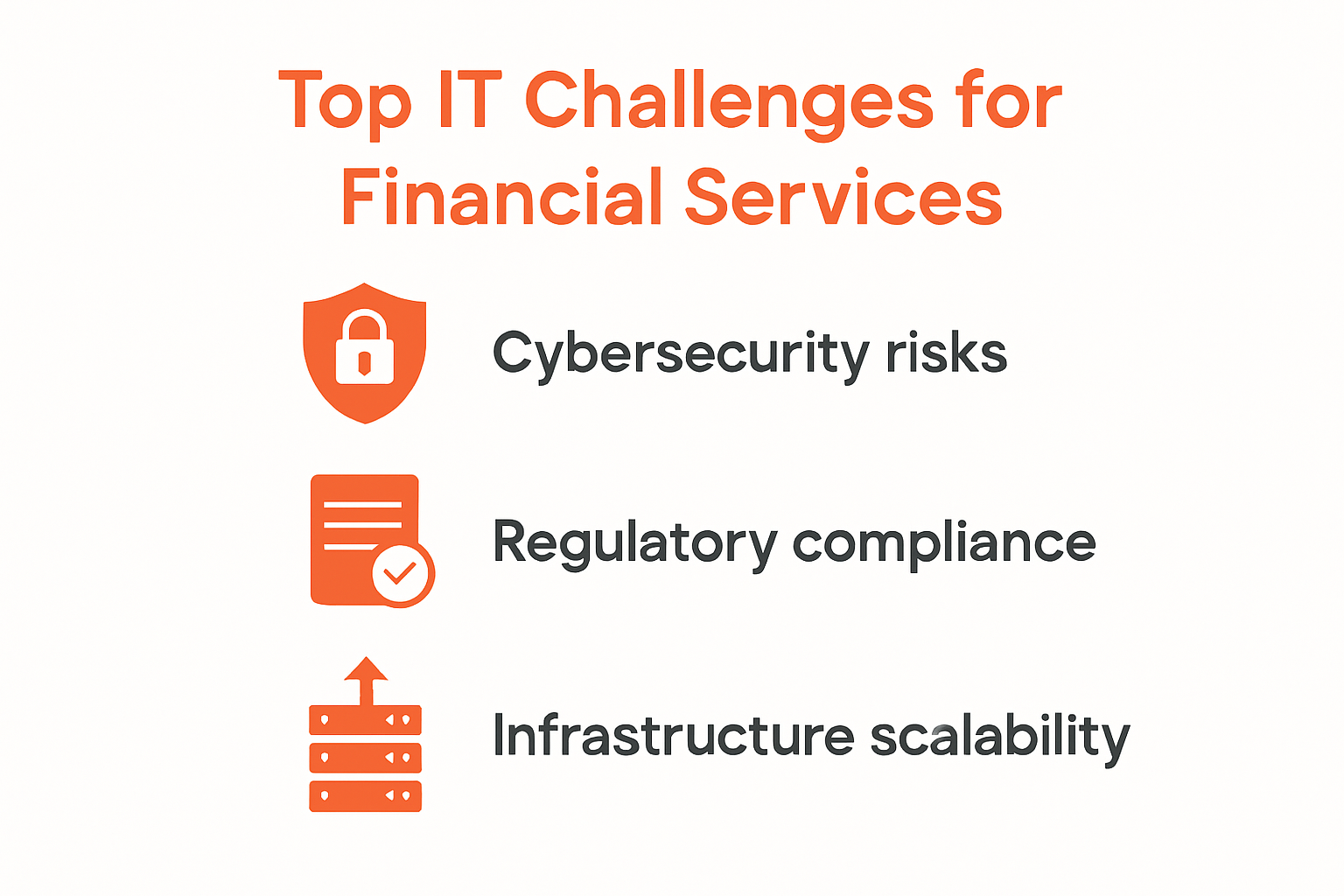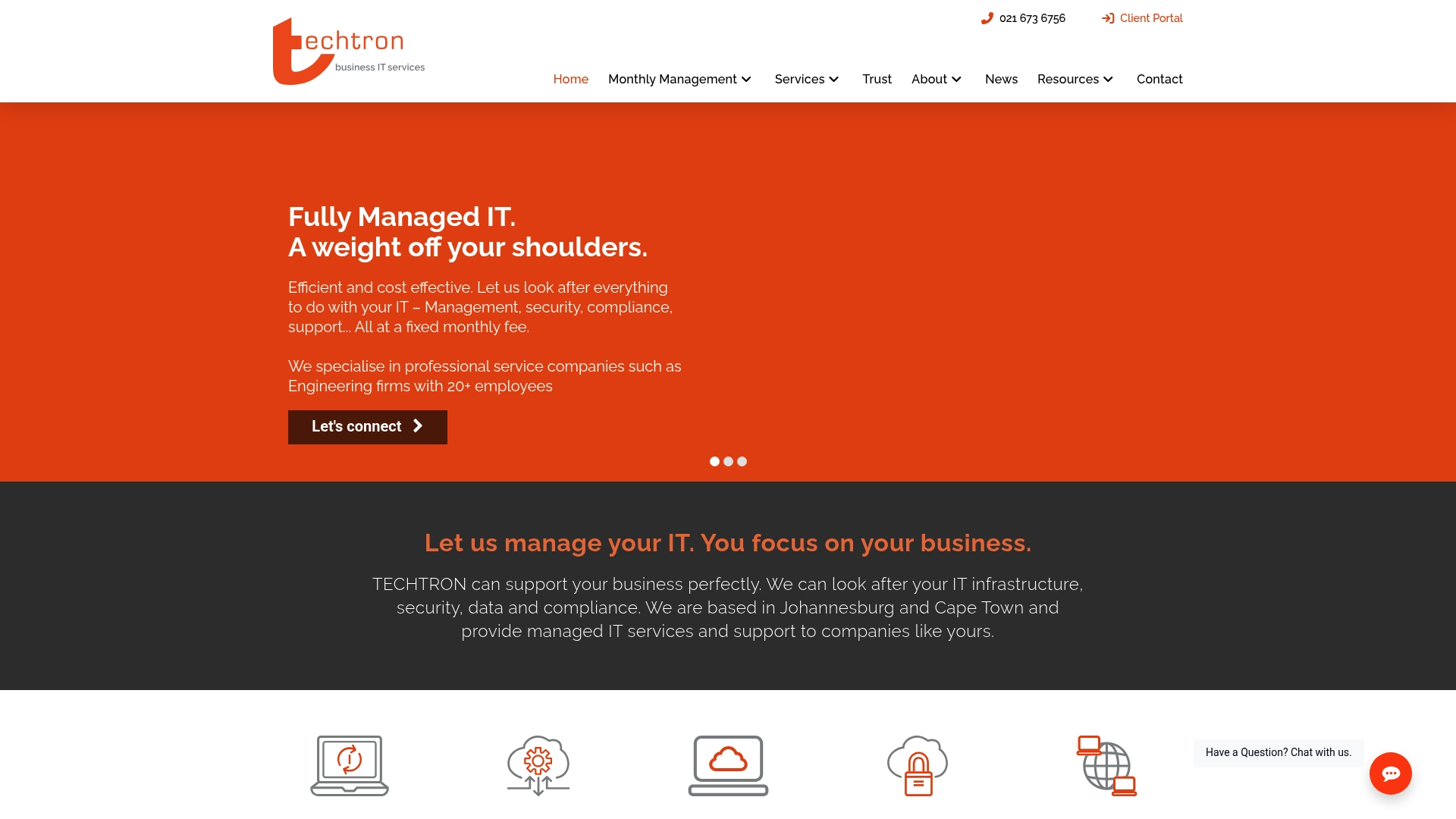IT Support for Financial Services: 2025 Guide for Secure Growth

Financial services in South Africa are sitting on a digital tightrope. Cyber attacks are getting sharper and regulations are tightening by the month. Here’s something that flips the script though. Outsourcing IT support can deliver cost savings of up to 40 percent, making it not only safer but smarter for banks and investment firms. The real surprise is that the biggest threat these days isn’t just hackers or compliance fines. It’s sticking with old systems while your rivals get faster, cheaper, and harder to hack with expert help.
Table of Contents
- Key IT Challenges In Financial Services
- Cybersecurity And Regulatory Compliance Essentials
- Benefits Of Outsourced IT Management
- Selecting A Trusted IT Support Partner
Quick Summary
| Takeaway | Explanation |
|---|---|
| Cybersecurity is Critical | Financial institutions face heightened cybersecurity threats, underscoring the necessity for advanced protection measures against potential data breaches and hacking attempts. |
| Regulatory Compliance is Complex | Organizations must navigate a rigorous regulatory environment, necessitating comprehensive risk management and compliance programmes to protect against financial irregularities and maintain customer trust. |
| Outsourcing Offers Strategic Advantages | Leveraging outsourced IT management can lead to significant cost savings, access to technological expertise, and operational flexibility, which are crucial for adapting to evolving digital infrastructures. |
| Selecting a Partner is Strategic | Choosing the right IT support partner requires evaluating compliance knowledge, technical capabilities, and strategic alignment to ensure effective technological governance and innovation. |
Key IT Challenges in Financial Services
Financial services organizations face increasingly complex technological challenges that demand strategic and proactive IT support. The digital transformation of financial systems has introduced unprecedented risks and operational complexities that require sophisticated management and robust security protocols.
Cybersecurity Vulnerability Landscape
Cybersecurity remains the most critical challenge for financial services. According to International Monetary Fund research, the South African financial sector’s high level of interconnectedness amplifies potential cyber risks. Financial institutions are prime targets for sophisticated cyber attacks, with threat actors continuously developing more advanced intrusion techniques.
The primary cybersecurity challenges include:
- Data Breach Risks: Protecting sensitive financial customer information from unauthorized access
- Network Penetration: Preventing sophisticated hacking attempts targeting critical financial infrastructure
- Compliance Vulnerabilities: Maintaining stringent security standards across complex technological ecosystems

Regulatory Compliance and Technology Integration
Navigating the complex regulatory environment presents another significant challenge for financial service IT support. South African Reserve Bank guidelines emphasize the need for technological solutions addressing digital identity verification, data portability, and risk mitigation.
Financial organizations must simultaneously manage:
- Technological Adaptation: Implementing cutting-edge security technologies
- Regulatory Alignment: Ensuring complete compliance with evolving financial technology regulations
- Risk Management: Developing comprehensive strategies to mitigate potential technological and operational risks
Infrastructure Scalability and Performance
As financial services become increasingly digital, infrastructure scalability emerges as a critical challenge. Organizations must develop IT support strategies that can accommodate rapid technological changes while maintaining optimal performance and security.
Key infrastructure considerations include:
- Cloud Migration: Securely transitioning legacy systems to modern cloud platforms
- Performance Optimization: Ensuring real-time transaction processing and minimal system latency
- Technological Resilience: Creating robust backup and disaster recovery mechanisms
The complexity of these challenges underscores the critical importance of specialized IT support for financial services. Proactive, comprehensive technological management is no longer optional but essential for sustainable growth and operational integrity.
By addressing these key IT challenges through strategic planning, advanced security protocols, and adaptive technological solutions, financial services organizations can transform potential vulnerabilities into opportunities for innovation and competitive advantage.
To help clarify the key IT challenges faced by financial services in South Africa, the following table summarizes the primary issues and core considerations for each area.
| Challenge Area | Core Issues | Key Considerations |
|---|---|---|
| Cybersecurity | Data breaches, network penetration, compliance vulnerabilities | Advanced protection, continuous monitoring, regulatory adherence |
| Regulatory Compliance | Technology adaptation, regulatory alignment, risk management | Up-to-date technology, comprehensive policies, risk assessment |
| Infrastructure | Cloud migration, performance optimization, resilience | Scalable systems, disaster recovery, real-time processing |
Cybersecurity and Regulatory Compliance Essentials
In the rapidly evolving financial services sector, cybersecurity and regulatory compliance have become inseparable components of organizational resilience. Financial institutions must navigate a complex landscape of technological risks and stringent regulatory requirements to protect their operations and maintain customer trust.
Comprehensive Regulatory Framework
The South African financial sector operates under a rigorous regulatory environment that demands meticulous compliance. The Financial Intelligence Centre Act requires financial institutions to develop comprehensive risk management and compliance programmes. These programmes must include robust customer due diligence processes, sophisticated transaction monitoring systems, and immediate reporting of suspicious activities to prevent money laundering and terrorist financing.
According to International Monetary Fund research, financial institutions must establish clear cyber strategies, governance frameworks, and resilience programs to effectively manage the dynamic nature of cyber threats.
Key regulatory compliance elements include:
- Risk Assessment: Conducting comprehensive and ongoing risk evaluations
- Documentation: Maintaining detailed records of compliance mechanisms
- Reporting: Implementing transparent reporting systems for potential financial irregularities
Evolving Cybersecurity Strategies
The South African Reserve Bank has introduced Joint Standard 2 of 2024, effective from 1 June 2025, mandating financial institutions to implement comprehensive cybersecurity and cyber resilience frameworks. This standard represents a significant shift towards proactive technological defense strategies.
Modern cybersecurity strategies must address multiple dimensions:
- Threat Detection: Implementing advanced monitoring and early warning systems
- Incident Response: Developing rapid and effective breach response protocols
- Continuous Training: Ensuring ongoing staff education on emerging cyber risks
Technology and Compliance Integration
Successful financial institutions recognize that technology is not just a tool for compliance but a strategic enabler. Explore our insights on cybersecurity trends to understand how technology can transform regulatory challenges into competitive advantages.
Effective integration requires:
- Adaptive Technologies: Implementing flexible technological solutions
- Automated Compliance: Leveraging AI and machine learning for real-time regulatory monitoring
- Holistic Security Approach: Creating interconnected security ecosystems
The intersection of cybersecurity and regulatory compliance represents more than a technical challenge. It is a strategic imperative that demands continuous innovation, investment, and a proactive approach to risk management. Financial services organizations must view these requirements not as obstacles but as opportunities to demonstrate technological sophistication and commitment to customer protection.
Benefits of Outsourced IT Management
In the dynamic financial services landscape, outsourced IT management has emerged as a strategic solution for organizations seeking technological excellence and operational efficiency. The evolving nature of digital infrastructure demands specialized expertise and adaptive technological approaches that internal teams often struggle to maintain.

Cost Efficiency and Resource Optimization
Outsourcing IT management provides financial services organizations with significant economic advantages. Research from South African IT journals indicates that firms can achieve cost savings of up to 40% by leveraging external IT support. These savings arise from eliminating the need for extensive in-house technological infrastructure, continuous staff training, and expensive equipment upgrades.
Key cost optimization strategies include:
- Predictable Expenditure: Converting unpredictable capital expenses into manageable operational costs
- Reduced Recruitment Overhead: Eliminating complex hiring processes for specialized technological talent
- Scalable Resource Allocation: Adjusting technological support precisely to organizational requirements
Expertise and Technological Innovation
Professional IT management providers bring comprehensive technological expertise that goes beyond traditional support models. According to Women on Top business analysis, outsourced IT teams offer financial institutions access to cutting-edge technological solutions and specialized knowledge that would be prohibitively expensive to develop internally.
Critical expertise dimensions include:
- Advanced Cybersecurity Protocols: Implementing state-of-the-art protection mechanisms
- Compliance Management: Ensuring continuous alignment with evolving regulatory standards
- Strategic Technology Planning: Developing forward-looking technological roadmaps
Operational Flexibility and Risk Mitigation
Outsourced IT management provides financial services organizations unprecedented operational flexibility. Read our comprehensive guide on service agreements to understand how strategic partnerships can transform technological management.
Operational benefits encompass:
- Rapid Response Capabilities: Immediate technological support and incident resolution
- Continuous Monitoring: 24/7 infrastructure and security surveillance
- Business Continuity: Robust disaster recovery and backup strategies
The table below provides an overview of the primary benefits of outsourced IT management for financial services, mapped to the specific solutions they provide.
| Benefit | Specific Solution Provided |
|---|---|
| Cost Efficiency | Predictable operational costs, reduced recruitment costs |
| Resource Optimization | Scalable support and allocation as needed |
| Access to Expertise | Advanced cybersecurity, compliance management, tech roadmaps |
| Technological Innovation | Cutting-edge solutions and up-to-date technologies |
| Operational Flexibility | Rapid incident response, 24/7 monitoring |
| Risk Mitigation | Disaster recovery, business continuity planning |
The strategic value of outsourced IT management extends far beyond simple cost reduction. It represents a holistic approach to technological governance that enables financial services organizations to focus on core business objectives while maintaining technological resilience.
By partnering with specialized IT management providers, financial institutions can transform technological challenges into competitive advantages. The right outsourcing strategy becomes a catalyst for innovation, efficiency, and sustainable growth in an increasingly digital financial ecosystem.
Selecting a Trusted IT Support Partner
Choosing the right IT support partner represents a critical strategic decision for financial services organizations. The technological landscape demands a partner who can navigate complex regulatory environments, provide robust security, and deliver innovative solutions that align with organizational objectives.
Compliance and Regulatory Expertise
A trusted IT support partner must demonstrate comprehensive understanding of financial sector regulations. The Financial Intelligence Centre mandates specific compliance requirements that demand specialized technological expertise. Financial institutions need partners who can seamlessly integrate regulatory compliance into technological infrastructure.
Key compliance considerations include:
- Regulatory Knowledge: Deep understanding of financial sector technological regulations
- Audit Trail Management: Capability to maintain comprehensive documentation and reporting mechanisms
- Risk Management: Proactive identification and mitigation of potential compliance vulnerabilities
Technical Capabilities and Security Protocols
Beyond regulatory compliance, technical proficiency represents a fundamental criterion for selecting an IT support partner. According to Government Technical Advisory Centre research, professional technical advisory services emphasize the importance of comprehensive technological capabilities.
Critical technical evaluation criteria encompass:
- Cybersecurity Sophistication: Advanced threat detection and prevention mechanisms
- Infrastructure Resilience: Robust backup and disaster recovery solutions
- Technological Adaptability: Proven track record of implementing cutting-edge technological innovations
Strategic Partnership Alignment
Effective IT support transcends transactional service delivery. Learn more about selecting the right service agreement to understand the nuanced approach required for successful technological partnerships.
Strategic partnership dimensions include:
- Cultural Compatibility: Alignment of organizational values and technological vision
- Scalability: Capacity to grow and adapt with changing organizational requirements
- Continuous Innovation: Commitment to ongoing technological research and development
For financial services evaluating IT support partners, the following checklist table maps the essential qualities to look for and their main roles in a trusted relationship.
| Key Quality | Role in Trusted Partnership |
|---|---|
| Deep Regulatory Expertise | Ensures compliance and risk mitigation |
| Audit Trail Management | Facilitates transparency and reporting |
| Advanced Cybersecurity | Protects against evolving threats |
| Infrastructure Resilience | Enables backup, disaster recovery, business continuity |
| Technological Innovation | Delivers up-to-date solutions and future-ready strategies |
| Scalability & Cultural Fit | Supports long-term growth and organisational alignment |
The selection process demands a holistic evaluation that considers not just current technological capabilities, but future potential. Financial services organizations must view their IT support partner as a strategic collaborator capable of driving technological transformation.
Ultimately, the right partnership enables financial institutions to focus on core business objectives while maintaining technological excellence. By carefully assessing potential partners across compliance, technical proficiency, and strategic alignment, organizations can establish a robust technological foundation that supports sustainable growth and innovation.
Frequently Asked Questions
What are the key IT challenges in financial services?
The main IT challenges include cybersecurity threats, regulatory compliance complexity, and infrastructure scalability. Financial institutions must ensure they have advanced security measures in place, comply with strict regulations, and optimize their infrastructure for performance and scalability.
How can outsourcing IT support benefit financial services?
Outsourcing IT support can lead to significant cost savings, access to advanced technological expertise, and operational flexibility. Financial institutions can save up to 40% on IT costs while leveraging the latest technologies and best practices.
Why is cybersecurity crucial for financial services?
Cybersecurity is critical for financial services due to the sensitive nature of financial data and the increasing sophistication of cyber threats. Financial institutions are prime targets for hackers, so they must implement robust security measures to protect customer information and maintain trust.
What should financial services look for in an IT partner?
Financial services should look for partners with deep regulatory expertise, strong technical capabilities, and a commitment to continuous innovation. The right partner should ensure compliance, provide advanced cybersecurity measures, and be adaptable to changing technology needs.
Ready to Secure Your Financial Firm’s Future?
The financial world is under pressure. As highlighted throughout this guide, managing cybersecurity, staying compliant and keeping your technology resilient are daily battles. Many financial service providers in South Africa are dealing with aging infrastructure, rising regulatory fines and the fear of a data breach. Your focus should be on clients and growth, not on IT headaches. By outsourcing to a trusted partner, you can solve these pain points while saving up to 40 percent on technology operations.

Take the next step towards serious security and efficient compliance. Let the experts at Techtron remove technical uncertainty with fully managed IT, cloud, and cybersecurity services designed for financial businesses. Visit our home page and discover how professional support, cloud integration and proactive management will help your firm turn risks into opportunities now. Make your IT a growth driver and secure your clients’ trust today.